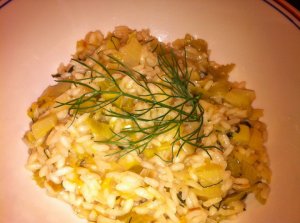Happy new year!
I made this risotto for Christmas dinner this year, and it was light and lovely. The white wine is optional–I find it adds a sweet tang to the risotto, but if you don’t want to add it, it won’t hurt.
Risottos are a labor of love–they take about 25-30 minutes to cook, and you are stirring constantly, so don’t start this unless you have the time.
You need:
- Two medium-sized leeks, whites only, finely chopped.
- One medium-sized onion, finely chopped.
- Two sticks celery, finely chopped.
- 5 cups vegetable stock
- 1 cup white wine (a nice one you could drink while cooking)
- 1 cup arborio or other risotto rice
- 1 tbsp olive oil
- 1/4 cup grated aged gouda (I used Rembrandt–you could also use other cheese, like parmesan or romano)
- Himalayan pink salt (or sea salt, or whatever salt you have), to taste
- White pepper (or black), to taste
- 2-3 sprigs of thyme
How to:
- Heat the oil in a large pan or dutch oven. I used a saute pan, but make sure it’s a heavy-bottomed pan. Keep the heat on medium.
- Add the onions, leeks, and celery and sweat them–cook until the vegetables are soft, stirring frequently. Add the salt. Don’t caramelize them, but they should be near that point. They shouldn’t turn brown. If they are starting to stick to the bottom, lower the heat.
- Add the rice, stirring frequently until the rice turns translucent. This may take a few minutes. The middle of the rice will still be white.
- Add the white wine and cook, stirring frequently until the wine is cooked off. If you are not using wine, simply skip this step.
- Add the thyme and stir gently.
- Add the stock, a cup at a time. Here’s how. Add a cup of stock. Cook, stirring often. When it is almost cooked out, add another cup of stock. Repeat. Keep doing this until the rice is cooked. It should be cooked al dente–still a little hard, but done through. Risotto typically has a creamy consistency.
- Add the pepper and stir gently.
- Turn off the heat, add the cheese, stir, remove the thyme, and serve hot.
I have frozen this risotto, but it lost something in texture and flavor when I reheated it.
Variations:
- Replace one leek with a small bulb of finely chopped fennel.
- Instead of the thyme, use rosemary or basil or fennel fronds.
- Replace the white wine with 2 tbsp 18-year balsamic vinegar + 2/3 cup water.
- Replace the white wine with red wine. Note: this will totally change the color of the risotto.
- Replace the white wine with a dark beer. Note: while wine adds a tangy aftertaste, beer can give it a hoppy, bitter aftertaste. Not for everyone.
- After adding cheese, add toasted almonds or crushed pecans.
- Top with panko breadcrumbs. Do not mix these in as they might (just might) get a wee bit soggy.
